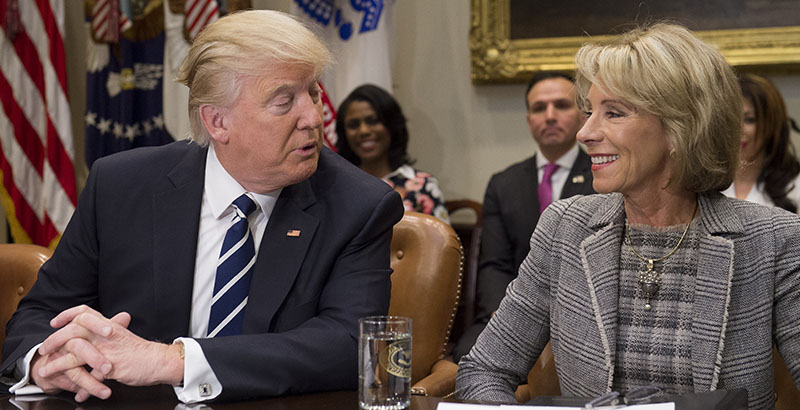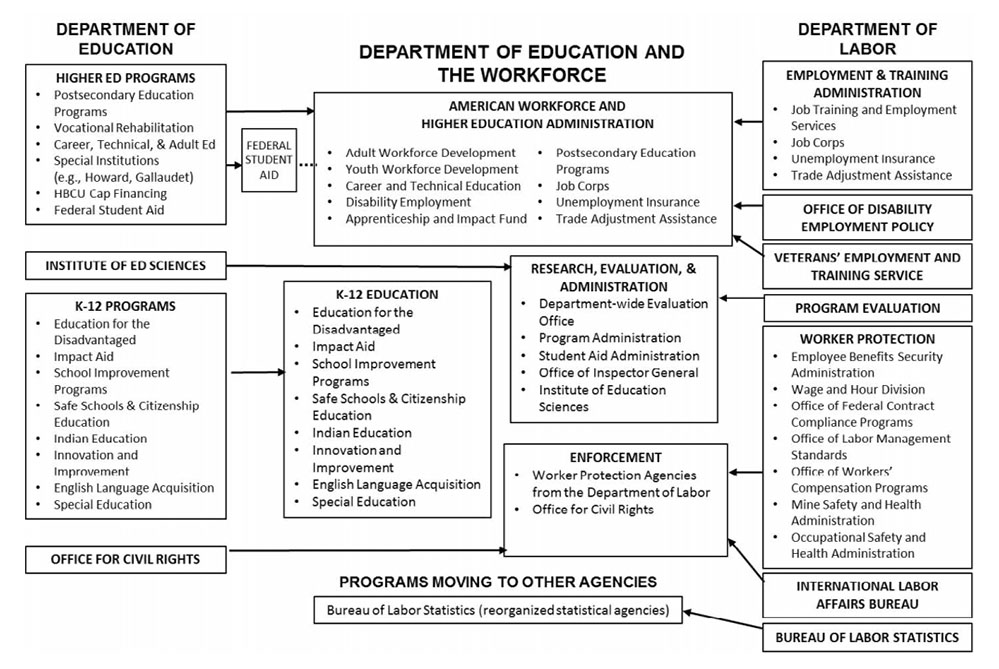The Department of Education and the Workforce: Why Trump Officials Are Looking to Merge Two Agencies, With a Focus on Better Developing a Modern Workforce

The Trump Administration Thursday offered a long-shot proposal to combine the Education and Labor departments into one federal agency.
The plan would combine them into what would be called the Department of Education and the Workforce. It would require congressional approval, which seems unlikely anytime soon, given pushback from Democrats, a sharply divided Senate, and election year pressures to stay away from hot-button topics.
Administration officials emphasized what they said were the agencies’ overlapping goals of workforce preparation in making the case for the proposal.
Most other advanced and rapidly growing countries organize their governments this way, and it provides additional flexibility to meet workforce needs, Margaret Weichert, deputy director of the Office of Management and Budget, said on a call with reporters Thursday.
“The goal isn’t to downgrade any of the major missions of the two organizations, but really integrate and frankly upgrade our thinking about education and labor and preparing children for the workforce as well as reskilling adults as jobs change and shift,” Weichert said.
Under the proposal, major K-12 programs like Title I funding for low-income schools, special education, and English language acquisition would be grouped into one general K-12 agency. The agency could better integrate K-12 programs and “more effectively coordinate with higher education and workforce programs,” the White House said in its report.
Career and technical education and higher education programs would be grouped together with job training programs from the Labor Department into a new broad “American Workforce and Higher Education Administration.” The Office for Civil Rights would be combined with worker protection agencies from the Labor Department into one enforcement office.

Both departments are doing the same thing, trying to prepare people for the workforce, Mick Mulvaney, director of the Office of Management and Budget, said at a Cabinet meeting Thursday.
“Sometimes that’s education, sometimes it’s vocational training, but we’re all doing the same thing, so why not put them in the same place?” he asked.
Weichert, the OMB deputy, also pointed out that in Congress, education and labor programs are under the jurisdiction of one committee. Even the new name of the agency would mirror the House Education and the Workforce Committee, as Republicans renamed it when they took control of Congress in 1996 and again in 2010; Democrats from 2006 to 2010 had called it the Education and Labor Committee.
Education Secretary Betsy DeVos in a statement praised the plan as fulfilling Trump’s campaign promise to reduce the federal role in education.
“Artificial barriers between education and workforce programs have existed for far too long. We must reform our 20th century federal agencies to meet the challenges of the 21st century,” she said.
DeVos is among the best-known, and most controversial, of the 11 education secretaries. The plan did not indicate whether her role would be abolished and her responsibilities given to Labor Secretary Alex Acosta.
Joanne Weiss, who served as the department’s chief of staff during the Obama administration, said emphasizing the Education Department’s role in workforce training takes away from many of its primary missions, including the education of very young children and its focus on civil rights.
The Trump administration came under fire from its earliest days for actions that advocates say weaken civil rights protections, particularly for transgender students, victims of campus sexual assault, and students of color who face disproportionately harsh discipline.
“To view [the Education Department] as purely a vocational entity, which is in some ways the hidden message behind this, is way too narrow a definition of education in the U.S., and to do it in a way that hides the most vulnerable students inside a mega-agency just seems like a way to ignore the students who are the most vulnerable,” she told The 74.
Congressional reaction divided
Rep. Virginia Foxx, the Republican who chairs the Education and the Workforce Committee, said in a statement that the federal government is “long overdue for a serious overhaul” and that the proposal is “a recognition of the clear relationship between education policy at every level and the needs of the growing American workforce.”
Her Senate counterpart, Health, Education, Labor and Pensions Committee chairman — and former education secretary — Lamar Alexander was more tepid in his response.
“I think it’s always wise to look for greater efficiency in how our government operates and will study the proposal carefully,” he said through a spokesperson.
The Democrats whose committees would need to approve the change were sharply critical.
There is no evidence that merging the departments would strengthen the outcomes of either agency or improve outcomes for students or workers, Rep. Bobby Scott, the ranking Democrat on the House Committee, said in a statement.
“The Department of Labor is no more equipped to oversee elementary education policy than the Department of Education is prepared to enforce standards for coal mine safety. The logic behind this proposal is painfully thin,” he said.
Sen. Patty Murray, the ranking Democrat on both the HELP Committee and the Appropriations subcommittee with jurisdiction over the departments, immediately poured cold water on the idea, calling it “unrealistic, unhelpful, and futile.”
“Democrats and Republicans in Congress have rejected President Trump’s proposals to drastically gut investments in education, health care, and workers, and he should expect the same result for this latest attempt to make government work worse for the people it serves,” she said in a statement Thursday.
The Trump administration has spoken with members of Congress in the past 24 hours to “share our willingness to really engage in constructive dialogue on making change happen this time and not going the business-as-usual route that leads to inaction,” Weichert said.
Republicans have long proposed downsizing the department, which many see as undertaking duties not constitutionally appropriate for the federal government. The U.S. Department of Education was created by President Jimmy Carter and a divided Congress in the late 1970s.
Neal McCluskey, director of the libertarian Cato Institute’s Center for Educational Freedom, said the move is “slightly encouraging” in that it would eliminate a Cabinet-level executive whose job was solely to advocate for more federal education programs but doesn’t go far enough in ending those efforts.
“It’s good, it’s a move in the right direction, but it’s really just a baby step toward where they should be,” he said.
The overall government reorganization plan includes 32 specific proposals, including moving some food assistance programs, like supplemental nutrition assistance programs and the nutrition program for women, infants, and children commonly known as WIC, from the Agriculture Department to the Department of Health and Human Services. It would also rename it the Department of Health and Public Welfare.
Some have noted that the administration has sought for some time to reduce the numbers of Americans receiving this assistance, and that the word “welfare” is often pejorative.
“We are far more interested in the content and the substance of the proposals. It’s business as usual in Washington to politicize things and miss the spirit and the real drive for change. I’m hopeful that we don’t get distracted by political debates when we’re pursuing common-sense solutions,” Weichert said.
The Education Department has an annual budget of around $70 billion and a roughly 3,800-member staff, while the Labor Department, perhaps best known to the average American for its monthly jobs report, has a roughly $12 billion budget and a staff of about 14,000.
Get stories like these delivered straight to your inbox. Sign up for The 74 Newsletter

;)
